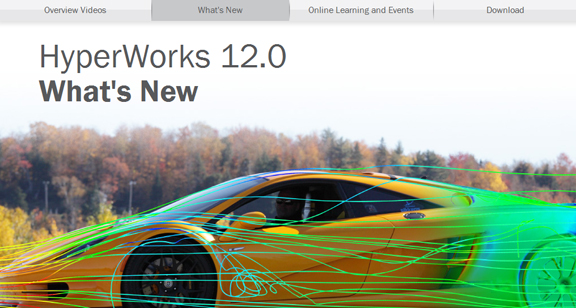March 5, 2013
Altair Engineering, best known for its simulation software, is rolling out a major release of its flagship suite, HyperWorks. The comprehensive lineup covers every phase of design development and testing, from computational fluid dynamics (CFD, with AcuSolve), crash analysis (HyperCrash), sheet metal form (HyperForm), and meshing (HyperMesh), to structural analysis (OptiStruct), and more. The latest upgrade, HyperWorks 12.0, emphasizes the growing importance of composite materials, optimization, and collaboration.
In the preparatory phase of simulation, HyperMesh now offers new algorithms that let you perform shell and solid meshing, along with a mid-plane mesh generator.“The 2D mid-plane generator is a major time-saver for people who need to extract 2D planes from CAD models,” said Stuart Sampson, director of modeling and visualization, Altair. “It’s a major step forward in model building.” It is, according to Sampson, one of the major choke points in the process.
HyperView, the application for viewing simulation results, now supports stereoscopic display, which adds realism and simulated depth to on-screen images. (You’ll need stereoscopic display hardware, graphics acceleration, and glasses to take advantage of this function.) “We’ve been getting lots of good feedback when we were showing it to users, especially for viewing crash simulation,” said Sampson.
The composite modeling and meshing tools give you a lot more controls over the orientation, layout, and character of plies. “In automotive, in Formula 1 teams, people have been using composite for a long time now,” said Sampson, “but I expect others will begin using it in other industries.”
In a seminar delivered at Swerea SICOMP, a European research institute, Brian O’Rourke, chief composite engineer for WilliamsF1, listed the use of polymeric matrix, metal matrix, and carbon composites as examples of composite application in F1 vehicle design.
For multiphysics problems, Altair HyperWorks lets you combine a variety of solver codes (for example, noise-vibration-hardness solver from OptiStruct, nonlinear crash test in RADIOSS, multibody dynamics in MotionSolve) to build a custom simulation loop. To encourage more users, the company now offers Multiphysics Licensing, described by Altair as “a novel multi-core licensing model [that] cost-effectively leverages HyperWorks and Altair Partner Alliance solvers for high-end multiphysics problems.”
Under this licensing scheme, no matter how many cores are used or how many codes are involved, “We just treat the whole multiphysics job as one job,” observed Detlef Schneider, senior VP, solvers, Altair. (In Altair’s licensing model, you purchase HyperWorks Units and pay for your jobs using them.)
For optimization, a process to automatically identify the best design to achieve your goals, you can rely on HyperStudy. The new version in 12.0, according to Altair, “is an entirely redesigned release [that] accelerates design robustness and reliability studies.”
Part of the emphasis of HyperStudy is data mining, the ability to correlate parameters and performance outcomes. One way HyperStudy makes it easy to see such relationships is through automatic plots and graphs. The tool is aimed at businesses that seek to explore multiple design possibilities through varying simulation inputs.
Anticipating cloud-powered visualization as the preferred collaboration method of the future, Altair previewed its Display Manager last November. The product is, according to Altair, “a new portal for remote visualization of extremely large models developed from Big Data resources.”
Display Manager enables users to run graphics-intensive applications on their cluster while visualizing those applications on their desktop, laptop, or other lighter devices. The lion’s share of visualization is performed by the GPUs on the server, thus the viewing device doesn’t need to be equipped with powerful processors or graphics accelerators. This function allows you, for instance, to view crash test results hosted in a data center through a simple web browser on a portable device or a laptop.
For more, visit Altair’s dedicated page for HyperWorks 12.0.
Subscribe to our FREE magazine, FREE email newsletters or both!
About the Author
Kenneth Wong is Digital Engineering’s resident blogger and senior editor. Email him at [email protected] or share your thoughts on this article at digitaleng.news/facebook.
Follow DE






